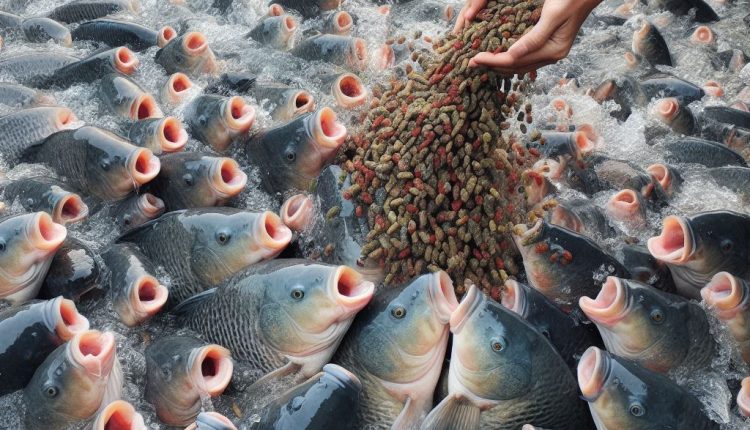FOR THE USE OF ENVIRONMENTALLY FRIENDLY AQUAFEED IN AQUACULTURE
By Dr Mustapha ABA, Aquaculture Scientific Expert, Fish Nutrition, Rabat. Morocco.
Aquaculture is the fastest growing food production system, and the sector accounts for more than half of all fish consumed. The growth of aquaculture has been facilitated by increased knowledge of fish nutrition. The science of fish nutrition allows us to establish a general diagram of the nutritional needs of aquaculture, in addition to these needs, it should be noted that the role of fish nutrition and food management has an impact on the productivity of the aquaculture system, the quality and safety of the environment.
Fish are pœcilothermic animals, with direct and indirect dependence on the environment, and are therefore more affected by changes in environmental conditions than terrestrial animals. Fish eating habits and diets not only directly influence their behaviour, structural integrity, health, physiological functions, reproduction and growth, but also modify the environmental conditions of the production system; water quality. Therefore, the optimization of fish growth can only be achieved through concomitant management of water quality, food and nutrition.
According to FAO (2024), globally, the share of non-fed aquaculture in total farmed animal species production fell from 60.3 percent in 2000 to 72.4 percent in 2020 and to 73.1 percent in 2022. Efficient feed formulation can only increase the sustainability of aquaculture, in addtion poor feed management at the farm level can result in nutritional deficiencies in the stock and/or excessive nutrient loading to the water system.
Overfeeding or unbalanced feed reduces the absorption of nutrients by fish, which can lead to excess organic matter in production systems. Under tropical conditions, this organic matter would quickly become mineralized. The nutrients regenerated in this process would be readily available for phytoplankton bloom, reducing transparency and affecting water quality, including the concentration of dissolved oxygen at night, leading to respiratory and biochemical stress with serious risks to fish health and potential losses in aquaculture production.
Intensive fish farming systems are characterized by high stocking densities and the use of complete diets, rich in protein and energy. As a result, fish eliminate high quantities and are exposed to high concentrations of metabolites, including ammonium and un-ionized ammonia (NH4+ and NH3-N) and nitrites (NO2-), their demand for dissolved oxygen in water continues to increase and is subject to stress due to variations in water quality parameters in aquaculture systems. on the role of fish nutrition and food management in system productivity and environmental quality and safety.
Aquaculture and the environment
The water is the most important natural resource on Earth, essential for the survival of all living organisms. Water can represent more than 70% of the weight of living organisms, both terrestrial and aquatic.
In countries or regions where water resources are abundant, problems related to water scarcity and pollution are less visible, but no less worrying, but in the case of Africa continent more vulnerable to drought, the “if” is no longer discussed; the flow of nutrients in the aquatic environment must be modified in the production systems of aquatic organisms. There is sufficient evidence that the rearing, feeding and nutrition practices of confined fish have a more or less severe environmental impact, depending on the intensity of the production regime.
Over the past decade, there has been an awareness and implementation of developing food with low impact on the aquatic environment and attention has been paid to the international aquaculture community, in order to reduce the volume and improve the quality of effluents from production basins, improve water quality and reduce surface water pollution.
Aquafeeds and aquaculture effluent
Effluents are all organic or inorganic waste from any agricultural, urban or industrial activity, discharged into the environment, treated or untreated. The quality and quantity of aquaculture effluent varies according to the production system, management techniques and production strategy adopted.
The use of food and feed, and the resulting nutritional management of fish, will define the severity of the environmental impact caused by aquaculture, in direct proportion to the intensification of production systems. In intensive systems, processed foods (rations) are the main or exclusive source of nutrients for fish and can represent up to 70% of production costs. If increased productivity is the main objective of nutritionists, the formulation of diets with minimal environmental impact should be taken into account, as it deteriorates water quality in production systems and negatively affects fish performance and, consequently, the productivity and profitability of systems.
Food waste and faeces are the main sources of waste (pollutants) in intensive fish manure. Many factors determine the role of food for aquatic organisms as agents of environmental impact: digestibility, palatability, stability in water, origin of protein sources (animal or vegetable), species’ eating habits and chemical composition of food, among others.
Phosphorus (P) and nitrogen (N) are among the wastes from aquaculture that can cause significant eutrophication in water collections. The indiscriminate release of nitrogen and phosphorus into the aquatic environment, particularly in fresh waters, is of concern because phosphorus is the most limiting nutrient in the production of primary algae and is therefore the most harmful. The same applies to nitrogen discharges, particularly in marine environments.

